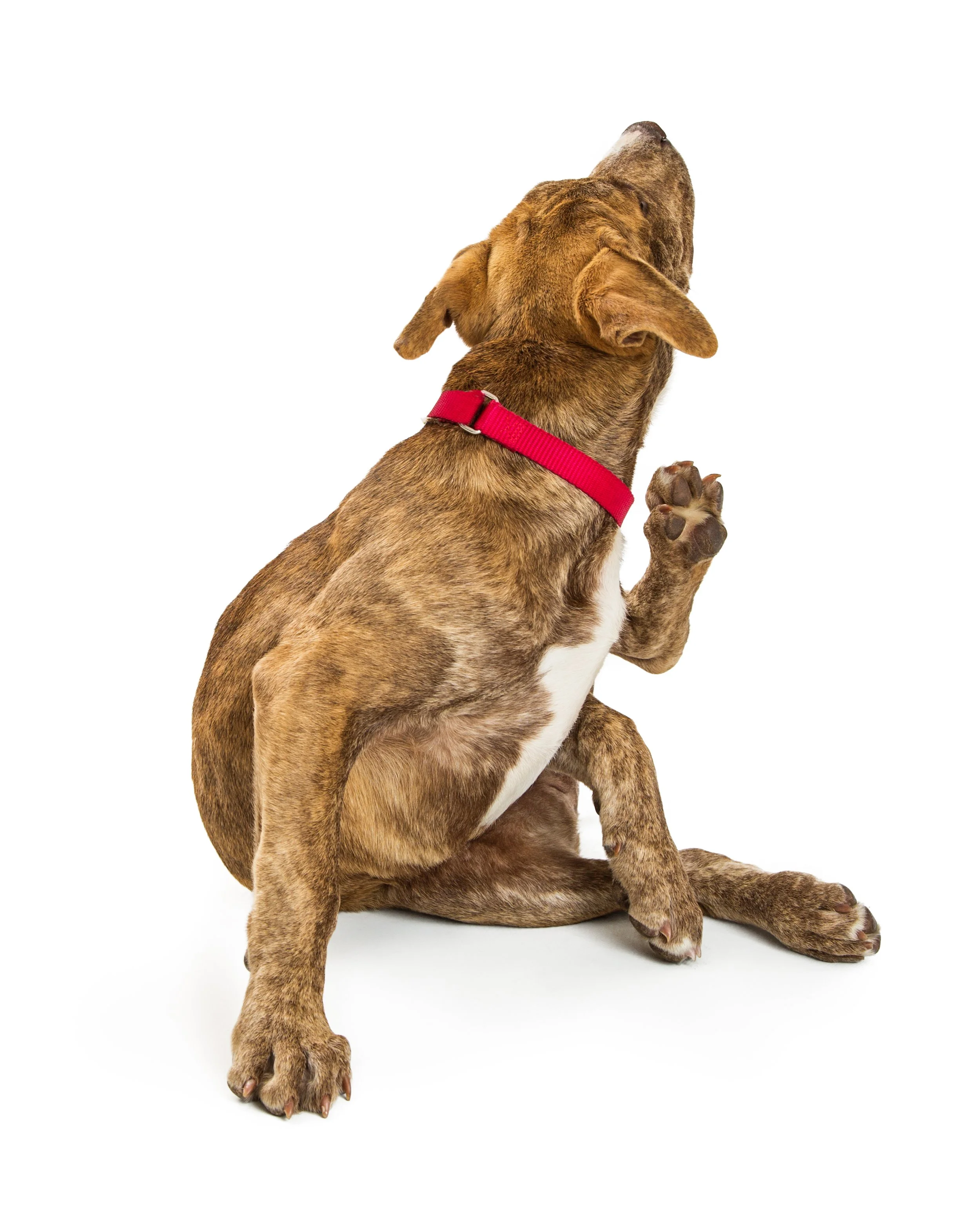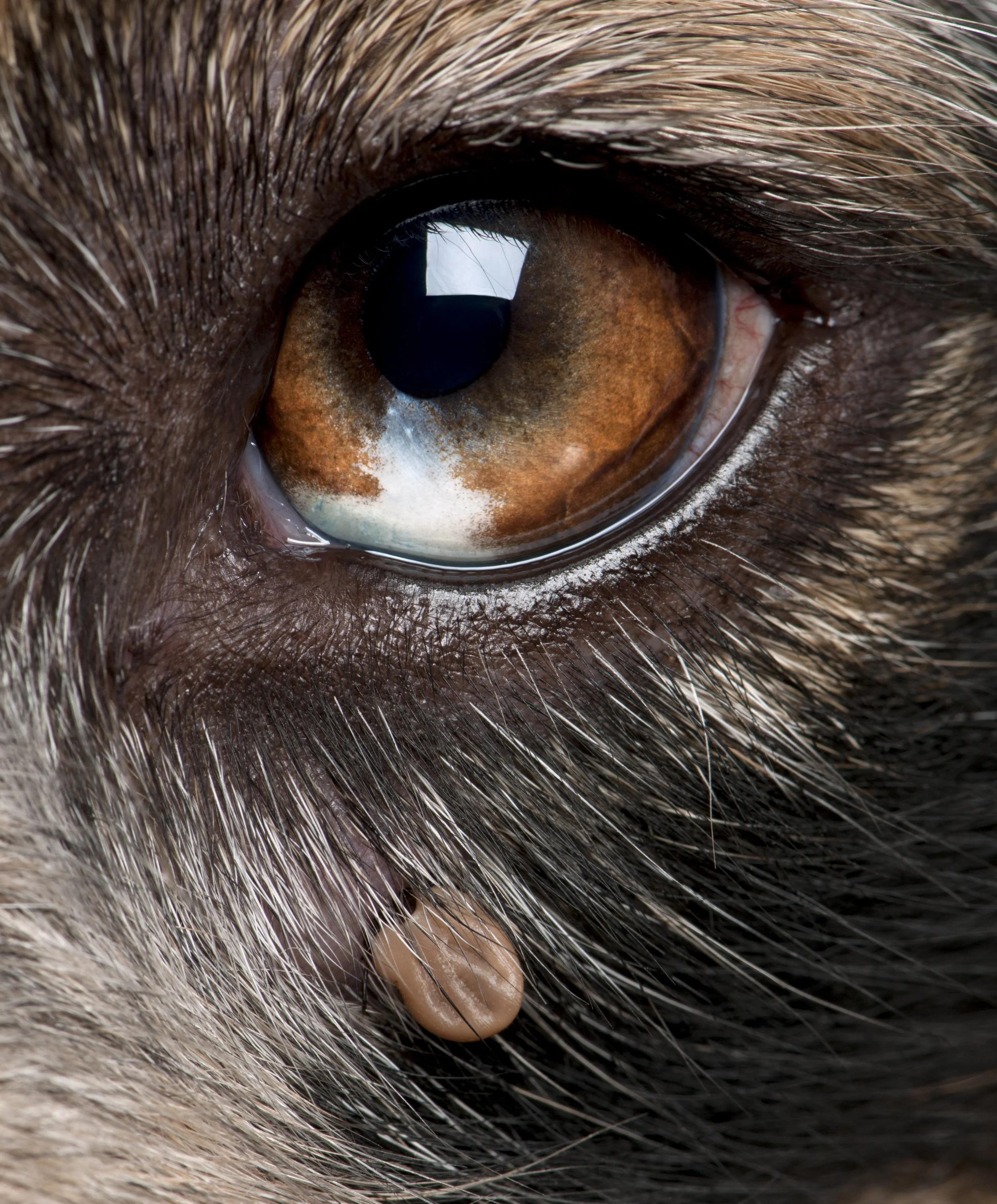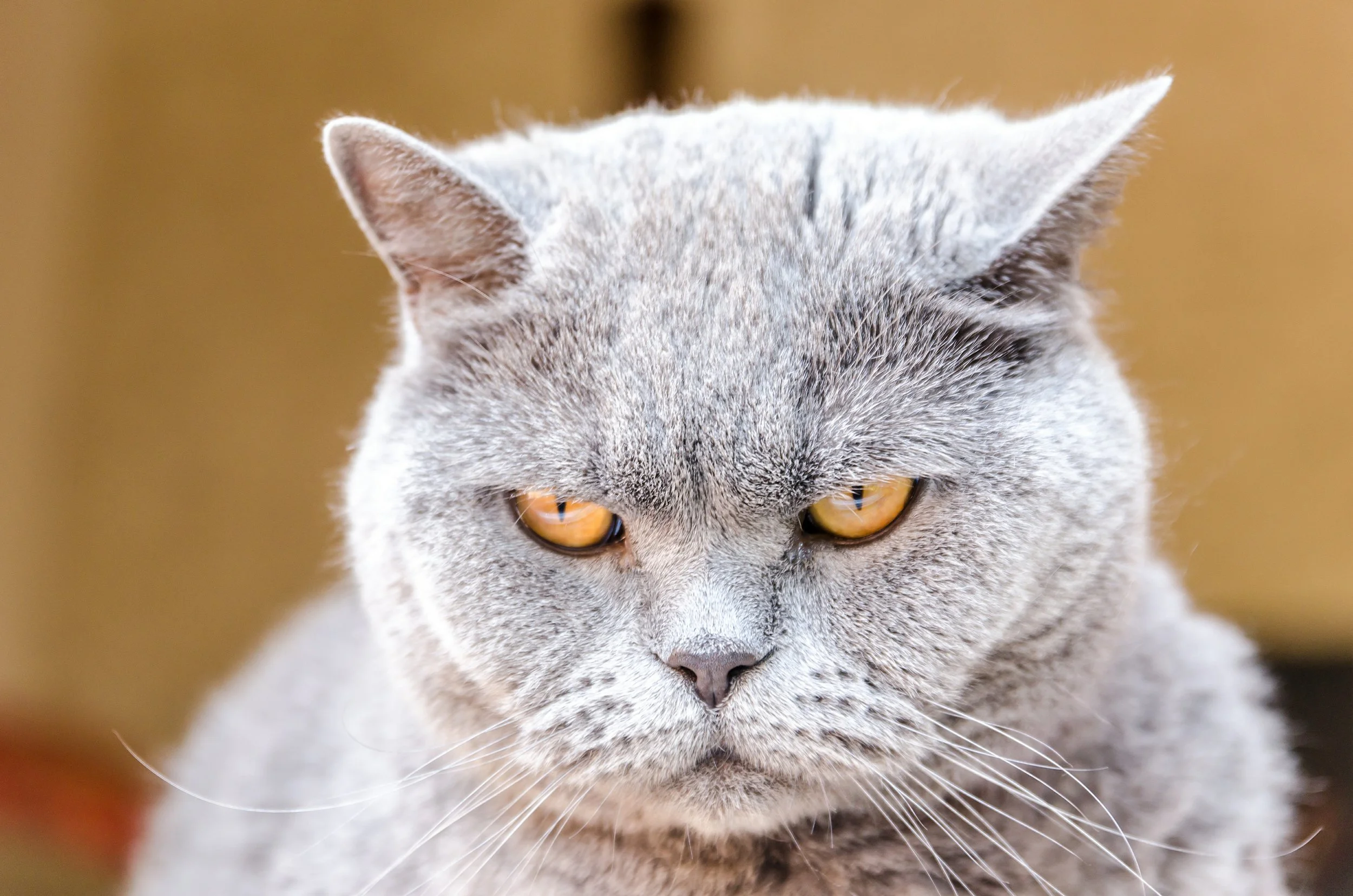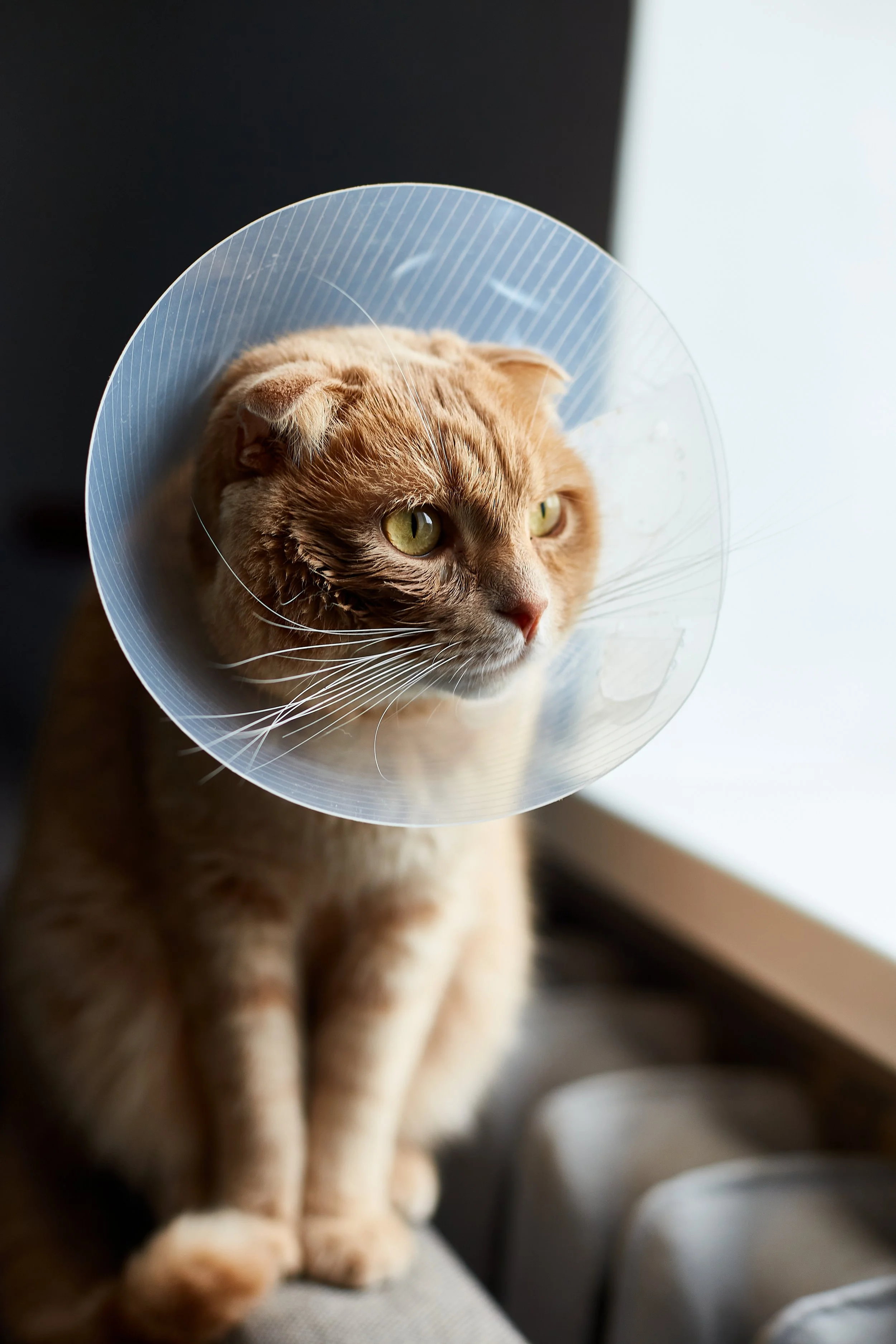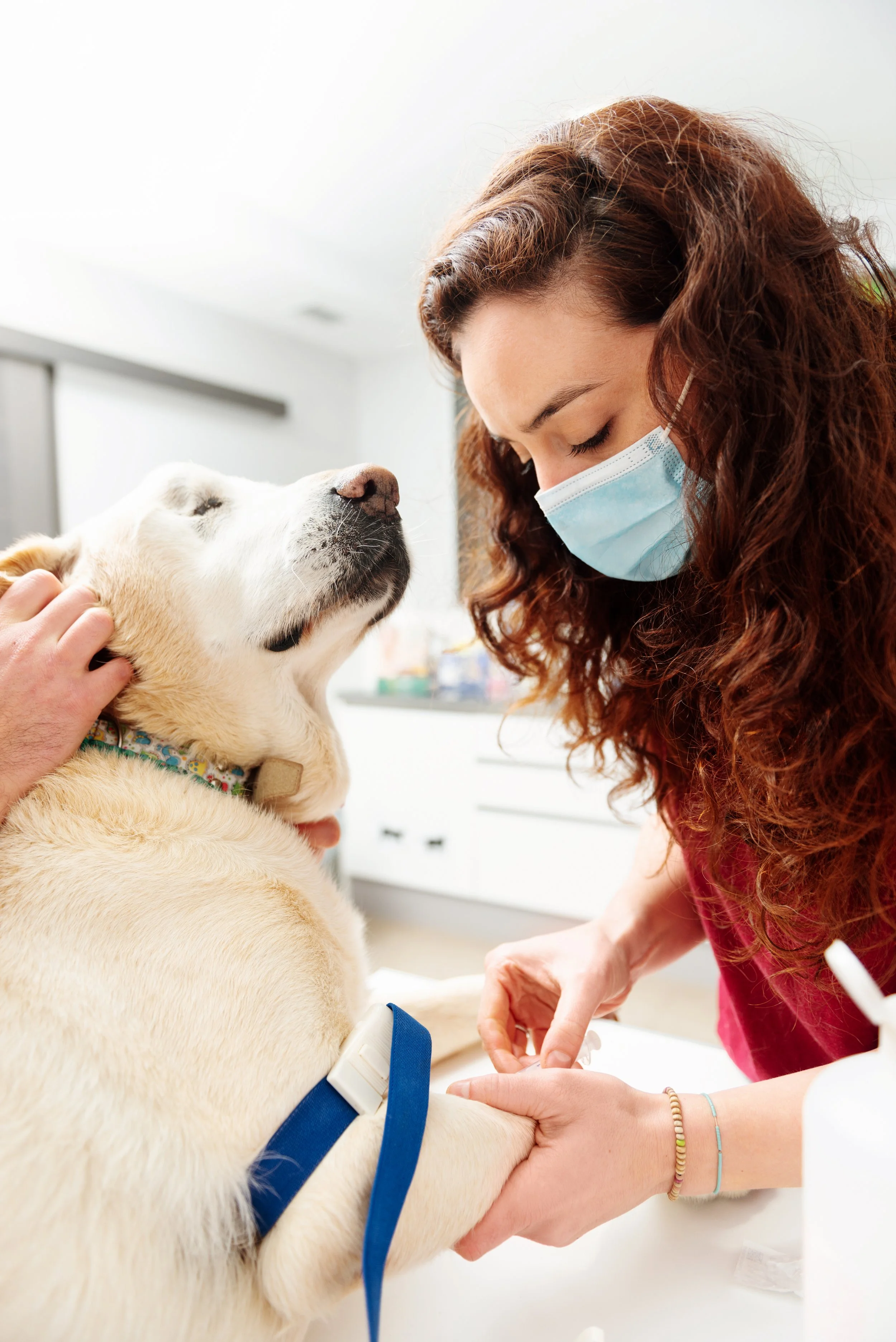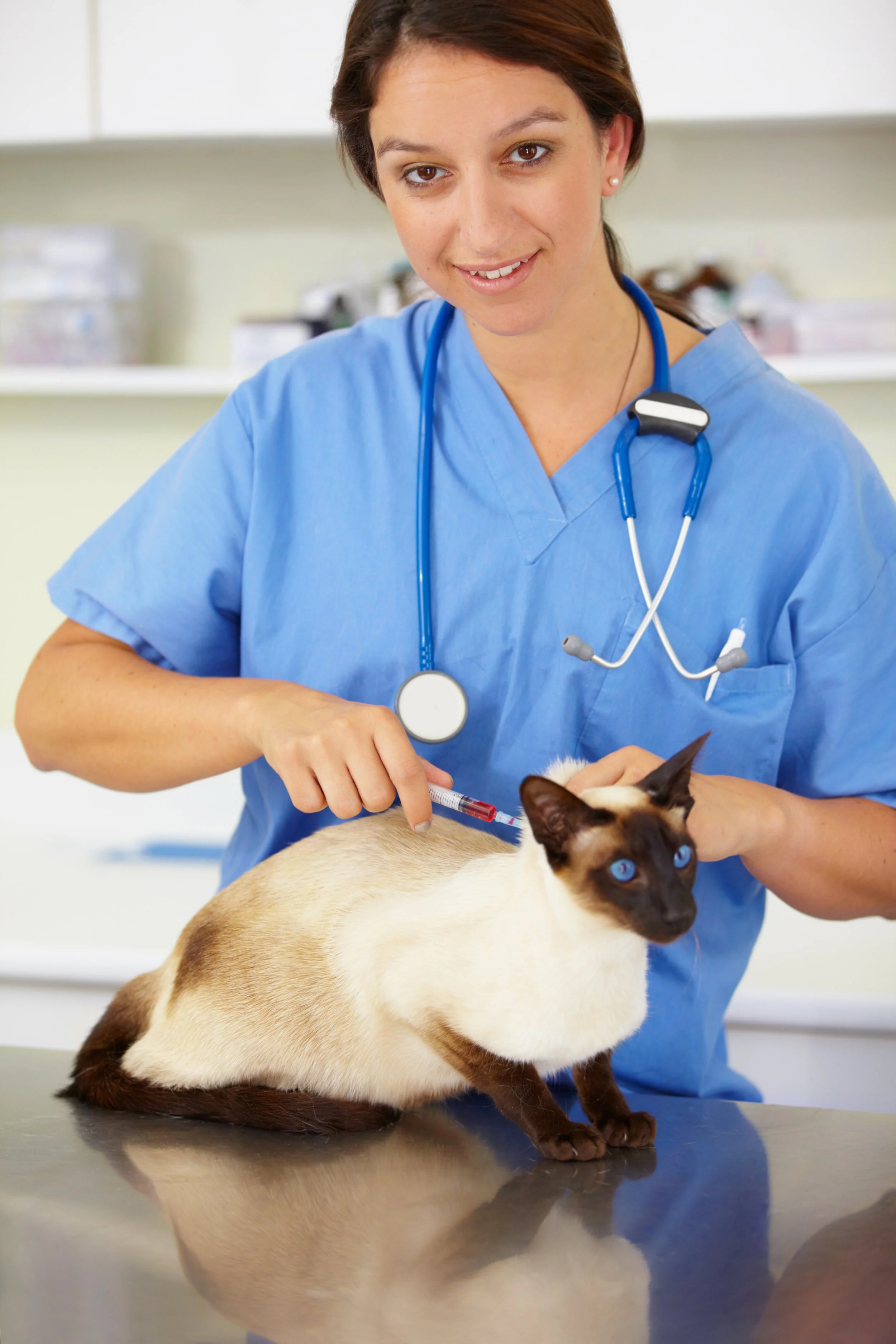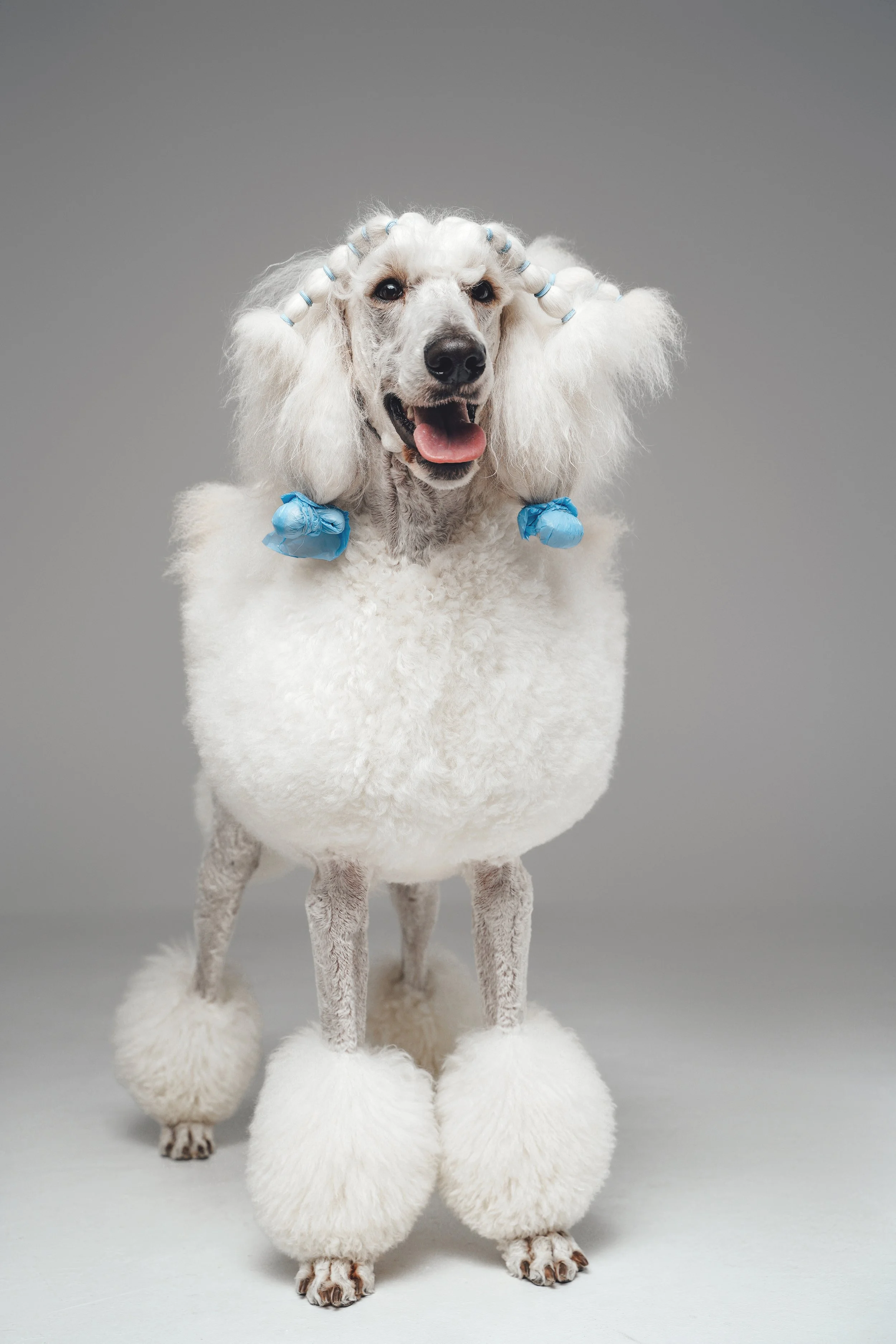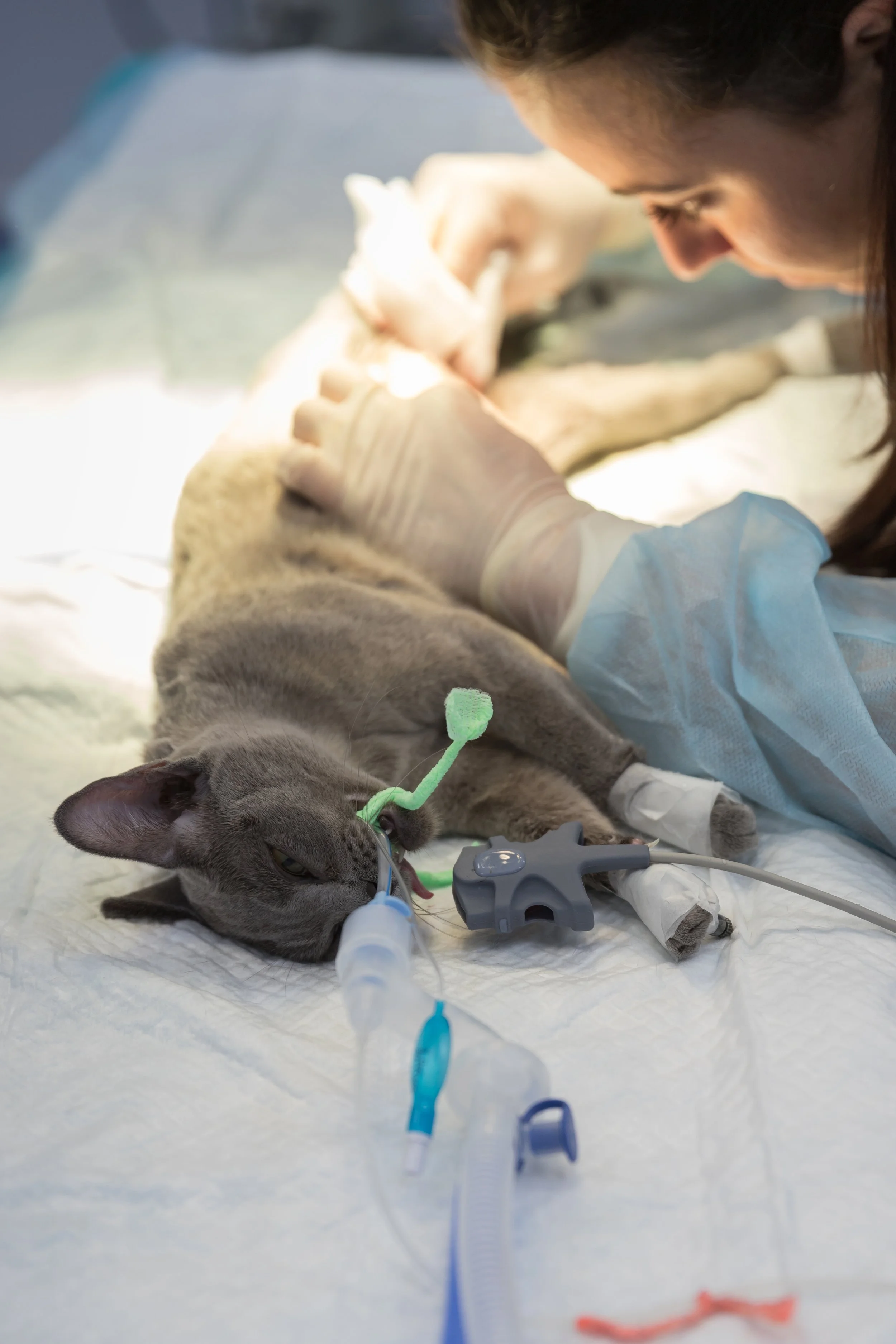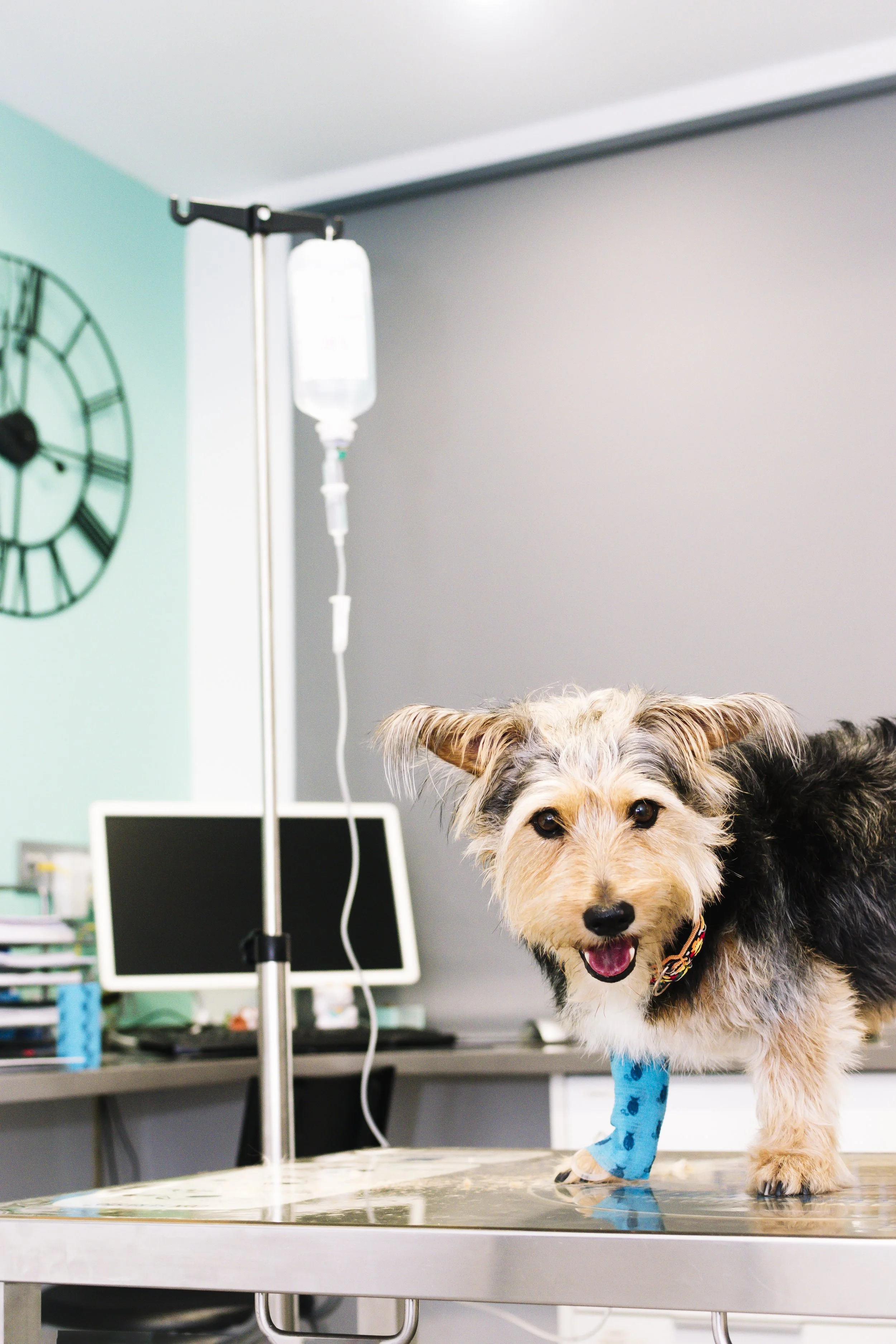Pet Wellness Programs
Your pet's wellness is why we are here. We understand how important your pets are to you and your family and we want to help you ensure a long and healthy life for all of your family's furry friends. We provide many pet health wellness programs because we understand that preventative pet health care is the best kind of care you can provide for your pets.
PREVENTATIVE PET CARE
Flea Control
Flea control starts with the flea’s life cycle a bit to get a perspective on controlling this beast (who’s been here for millennia and is not likely to leave without some very concerted efforts). If you picture a population pyramid of fleas as a representation of the relative numbers of the various life stages that exist at any given moment, the bothersome adult fleas that bite and cause problems would be only the very top, about 5% of the total. The broad base of the pyramid is the vast number of eggs, 50% of the total population. These are laid both on and off the host animal, and are awaiting proper conditions to hatch and begin a new generation. The next major population segment is the larvae (35% of the total), which emerge from the eggs and feed on debris and organic matter in carpets, soil, or in cracks and baseboards. Then, above these, a relatively small segment of the total (10%), are the pupae, suspended in a cocoon that seems impervious to all control efforts, natural or otherwise.
Pet Immunizations
Immunizations: Vaccines are very important to managing the health of your pet. That said, not every pet needs to be vaccinated against every disease. It is very important to discuss with your veterinarian a vaccination protocol that’s right for your pet. Factors that should be examined include age, medical history, environment, travel habits and lifestyle. Most vets highly recommend administering core vaccines to healthy pets.
For Dogs: Vaccines for canine parvovirus, distemper, canine hepatitis and rabies are considered core vaccines. Vaccines are given depending on the dog’s exposure risk. These include vaccines against Bordetella bronchiseptica, Borrelia burgdorferi and Leptospira bacteria.
For Cats: Vaccines for panleukopenia (feline distemper), feline calicivirus, feline herpesvirus type I (rhinotracheitis) and rabies are considered core vaccines. Vaccines are given depending on the cat's lifestyle; these include vaccines for feline leukemia virus, Bordetella, Chlamydophila felis and feline immunodeficiency virus.
Pet Parasite Control
Parasite Testing and Protection Guided by our Veterinarians:
Conduct preventive physical examinations at least every 6 to 12 months.
Conduct annual heartworm testing in dogs; test cats prior to placing on heartworm preventive and thereafter as indicated.
Test annually for tick-transmitted pathogens, especially in regions where pathogens are endemic or emerging.
Conduct fecal examinations at least four times during the first year of life, and at least two times per year in adults, depending on patient health and lifestyle factors.
Prescribe control programs to local parasite prevalence and individual pet lifestyle factors.
Adapt prevention recommendations to address emerging parasite threats.
In areas where Lyme disease is considered endemic or emerging, vaccinate dogs against Borrelia burgdorferi.
Preventative Pet Medicine
Preventative Medicine is prevention worth a pound of cure" certainly holds true when it comes to pet health.
The cost of preventative medicine is often a fraction of the cost of treating a disease or problem once it has become more advanced, and early diagnosis and treatment of developing problems or diseases can increase the likelihood of successful outcomes.
Preventive healthcare involves a multi-faceted approach that includes veterinary evaluation of your pet's overall health and risks of disease or other health problems. Based on the findings, our veterinarians will provide you with recommendations for your pet's nutrition, dental care, vaccinations and heartworm/flea/tick prevention, as well as recommendations specifically tailored to your pet's health status and risk factors.
Pet Tick Control
Tick control starts by examining your pet each time you return from a walk in the woods or a field. Ticks like to settle between the toes and around the ears on dogs, although they can latch on just about anywhere.
Ticks may be very small black dots, about the size of the head of a pin; or they can be larger and more easily seen, about half the size of a ladybug. When engorged with blood, the tick’s body swells and it holds firmly to the dog’s skin. Unfortunately, it’s often easiest to find a tick when it’s already latched on: by feeling your dog’s skin, you can find a tiny lump that feels much like a small burr, except you can’t brush or pull it off easily.
If you find a tick that’s unattached, you can remove it with a pair of tweezers. Because the blood of a tick can be dangerous, don’t crush it between your fingers. Also, flushing it down the toilet will not kill it — putting it in rubbing alcohol, then flushing it will do the job. It’s best to wear rubber or surgical gloves when you handle ticks.
If the tick has already burrowed its head into the dog’s skin, use a pair of tweezers and gently grasp the tick by the head, not the body. Pull gently, straight outward (though occasionally we recommend twisting clockwise). Dip it in rubbing alcohol and flush it down the toilet.
If the head remains in the skin, you may be able to remove it with tweezers. If not, it will likely come out on its own, but you should check with us for advice on whether to try to remove it or simply leave it and watch for signs of infection.
If your dog has had ticks, particularly a severe infestation, you’ll need to thoroughly clean their bedding area. Luckily, ticks — unlike fleas— usually don’t spread beyond the dog or her bed, although they do present an obvious danger to other animals and people in the house.
Weight Management
Did you know that obesity affects more than 50 percent of America's dog population? If your pet is overweight, they can develop all kinds of health problems, such as painful arthritis, heart disease, breathing difficulty, diabetes and even bladder cancer. For your dog, the excess weight and the resulting health problems can mean less play time and depression, thus making weight management very important. Weight gain is the result of an increase in body fat. This is usually caused by eating too much, especially when combined with lack of exercise. But there can be other contributing factors too.
Age: Older dogs are less active, have less energy, and require fewer calories.
Breed: Some dog breeds are more likely to gain weight. These include Labrador retrievers, and cocker and Cavalier King Charles spaniels.
Neutering/ spaying: Clinical studies have shown that the basic metabolism of neutered dogs is lower. Neutered dogs actually require fewer calories.
Medical Problems: Very occasionally weight gain is associated with a medical disorder that may require specific treatment
Overfeeding: Dogs with unlimited access to food understandably eat more than they need
Overeating: Many commercial foods are loaded with salt and fat. This improves taste, which means your dog will want to gorge
Feeding habits: Feeding table scraps and "people food" can lead to obesity
Feeding habits: Lack of exercise: Too much food and too little exercise produces a typical result: Obesity
IMPORTANT: Even if your pet does not show any signs of being overweight, it is important to have regular weight checks with us to make sure his ideal weight is maintained.
PRIMARY PET CARE
Geriatric Exams For Cats
Regular professional veterinary care is essential to the health of your geriatric/senior/older cat.
Preventive veterinary care can add years and quality to the life of your older cat. Tomball Animal Hospital's main goal is to keep your cat happy, healthy, and in a loving relationship with you for as long as possible.
Because many of our pets are living longer, and we recognize that the earlier in a disease process we can make a diagnosis and start treatment, the better the outcome, Tomball Animal Hospital have developed special geriatric preventive care program for older animals.
We offer different programs for geriatric exam's such as geriatric panels, geriatric wellness programs, geriatric screens, or senior care programs. These include combinations of various diagnostic tests including blood tests, urinalysis, fecal exams, radiographs (x-rays), and EKGs.
Ask our veterinarian team which tests are appropriate for your cat.
Geriatric Exams For Dogs
For geriatric dogs we recommend twice-yearly checkup's to keep up your geriatric/ senior quality of life.
The earlier in the disease process that a diagnosis is made, the earlier treatment can be started and, generally, the better the prognosis. Regular geriatric veterinary exams may also teach you about your pet and what to expect in the coming years.
Geriatric exams are also called "senior wellness exam. A geriatric exam consists of more than the checkups you are used to, and may include checking your pet’s weight (to check for obesity or unexpected loss of weight) as well as any combination of diagnostic tests.
Your pet will also get a full physical examination – your veterinarian will look at your pet from head to tail. At your pet’s first geriatric exam, tests will be performed to establish a "baseline" for comparison with your pet’s future diagnostic tests.
Sick Exams For Cats
All our physical examinations cover your cat from the “tip of the nose to the end of the tail”.
When your cat is sick, it may have obvious areas or concerns or may have subtle changes over time.
Our exams for the ill cat will focus on not only the physical abnormalities we find from the full physical examination of your cat but also on any changes in behavior or activity you have noticed that are associated with the illness.
Sick Exams For Dogs
Your pet is ill and you need honest, caring veterinary intervention for your sick dog.
Our veterinarians at Tomball Animal Hospital are devoted to providing you with a rapid and accurate diagnosis of your pet's illness.
We will work with you to help you understand your pet's condition, thoroughly communicating the diagnostic and treatment options available to best secure the most desired outcome of optimal and sustained return to good health.
Wellness Exams For Cats
Wellness exams for your cat is a great way to catch something early, before it becomes a major problem. This can save your cat needless suffering, increase the chance of a full recovery and can save money on long-term medical costs.
A routine wellness exam is also a great opportunity for preventive care. During an exam your veterinarian may be alerted to a potential problem and advise you on any recommended change in diet, medication or lifestyle. Routine blood work and diagnostic testing can catch potential problems in their earliest stages.
Wellness Exams For Dogs
A wellness exam for dogs is a complete physical examination along with diagnostic testing that may include blood work, urinalysis, and checking a stool sample for parasites.
In many cases, a wellness examination can help detect the early stages of disease.
Wellness exams include a complete physical examination from nose-to-tail, looking for any abnormalities. Your veterinarian will use special equipment, including a stethoscope to listen to the heart and lungs, an otoscope to view the inside of the ears, and an ophthalmoscope to examine the eyes.
Our veterinarian's will also feel all over your pet’s body for lumps and bumps. In addition, your veterinarian will check your pet’s vital signs (temperature, pulse, and respiration) and record your pet’s current weight.
Wellness Exams For Kittens
Your kitten needs appropriate vaccinations, tests, and check-ups during their fragile first months.
Kittens require a series of vaccinations to protect them from life-threatening viruses such as Feline Viral Rhinotracheitis, Calicivirus, Panleukopenia (FVRCP), Feline Leukemia (FeLV), and Purevax Rabies. These vaccinations, along with dewormings for roundworms and hookworms, and fecal checks for intestinal parasites will be administered accordingly throughout their three wellness exam visits (8 - 16 weeks of age). Your kitten’s initial examination will also include FeLV and FIV (Feline Immune Deficiency) testing.
Wellness Exams For Puppies
Wellness exams for puppy's is usually their first trip to the veterinarian is almost as much about educating you as checking out the puppy. Besides your many questions and concerns, you need to bring two things with your puppy to the first exam. The first is whatever health information the seller or shelter provided to you, such as records of vaccinations and wormings. The second is a fresh stool, which is examined for the presence of parasites.
ADVANCED PET CARE
Dog Neuters
Male dog neutering, otherwise known as sterilization, "fixing", desexing, castration (castrating) or by its correct veterinary name: orchiectomy (also termed gonadectomy), is the surgical removal of a male dog's testicles for the purposes of canine population control, medical health benefit, genetic-disease control and behavioral modification.
Considered to be a basic component of responsible pet ownership, the neutering of male dogs is a common surgical procedure.
Dog Spays
Dog spaying (bitch spaying procedure) - otherwise known as female neutering, dog sterilization, "fixing", ovary and uterine ablation, uterus removal or by the medical term: ovariohysterectomy - is the surgical removal of a female dog's ovaries and uterus for the purposes of canine population control, medical health benefit, genetic-disease control, and behavioral modification.
Considered to be a basic component of responsible female dog ownership, the spaying of female dogs is a simple and common surgical procedure.
Cat Neuters
Male cat neutering, otherwise known as sterilisation, "fixing", desexing, castration (castrating), or by its correct veterinary name: orchiectomy (also termed gonadectomy), is the surgical removal of a male cat's testicles for the purposes of feline population control, medical health benefit, genetic-disease control and behavioral modification. Considered to be a basic component of responsible cat ownership, the neutering of male cats is a simple and common surgical procedure that is performed by most veterinary clinics all over the world.
Cat Spays
Feline spaying (cat spay procedure) - otherwise known as spaying cats, female neutering, sterilization, "fixing", ovary and uterine ablation, uterus removal or by the medical term: ovariohysterectomy - is the surgical removal of a female cat's ovaries and uterus for the purposes of feline population control, medical health benefit, genetic-disease control, and behavioral modification. Considered to be a basic component of responsible female cat ownership, the spaying of female cats is a simple and common surgical procedure that is performed by veterinary clinics all over the world.
Dental Cleaning
Dental cleaning is a very important part of your pet’s overall health, and dental problems can cause, or be caused by, other health problems. Your pet’s teeth and gums should be checked at least once a year by your veterinarian to check for early signs of a problem and to keep your pet’s mouth healthy.
Veterinary dentistry includes the cleaning, adjustment, filing, extraction, or repair of your pets' teeth and all other aspects of oral health care.
The process begins with an oral exam of your pet’s mouth by a veterinarian. Radiographs (x-rays) may be needed to evaluate the health of the jaw and the tooth roots below the gumline. Because most dental disease occurs below the gumline, where you can’t see it, a thorough dental cleaning and evaluation are performed under anesthesia. Dental cleaning includes scaling (to remove dental plaque and tartar) and polishing, similar to the process used on your own teeth during your regular dental cleanings. Pain management is also included to help your beloved pet recover without pain.
Intensive Monitoring
Tomball Animal Hospital’s Intensive Care Unit (ICU) is similar to ICUs found in human hospitals, our ICU is equipped with the latest in diagnostic, monitoring, and support equipment. Our team of knowledgeable, dedicated doctors and veterinary technicians are always on-site to care for your pet when illness or disaster strikes.
Advanced treatment in our ICU includes:
Oxygen supplementation
Blood transfusions
Advanced pain treatment
Feeding tube placement
Chest tube placement
Intravenous nutrition
24-hour veterinary and nursing care
Respiratory therapy, including:
Oxygen therapy
Nebulization therapy
Blood gas values
Pulse oximetry
Pain management
Blood and plasma transfusion
IV fluids
Cardiovascular monitoring
Nutritional support
Intravenous Fluids
Intravenous Fluids or IV fluid administration may be necessary in some instances when a dog is severely ill and there are no alternative options. The subcutaneous fluid administered may contain nutrients, medication and serum, which will be necessary to heal the pet. The treatment may be administered at a clinic or at home.
The administration of subcutaneous fluids may be needed in a number of instances such as:
Liver or kidney disease, when you need to control what your dog eats and allow the organs to rest and recover
The dog is unconscious and needs to be fed
The pet is severely dehydrated and immediate hydration is needed
The dog is hypoglycemic
When the dog has severe anemia
During and after surgery, especially if the surgery is more complex
Orthopedic Surgery
It is important that you understand the complexity of both your pet’s problem and the surgical procedure that is to be performed. We will make every attempt to explain your pet’s condition to you as well as the benefits and risks involved with the proposed surgical procedure recommended to treat your pet’s problem.
While every effort is made to ensure your pet’s comfort and safety, there are a few things to consider:
Animals undergoing orthopedic procedures require general anesthesia. While our anesthesia faculty, staff, and equipment make Tomball Animal Hospital one of the safest places for your pet to have anesthesia, we never underestimate the seriousness of any anesthetic episode.
Due to the complexity of the conditions that we treat and the surgical procedures that we perform, postoperative complications may occur. These complications could require extended hospitalization and additional diagnostic or therapeutic procedures. We will try to discuss common potential complications with you prior to surgery; however, it is impossible to anticipate every complication associated with any surgical procedure.
Soft Tissue Surgery
Soft tissue surgery involves procedures not related to bones or joints. These can range from routine elective procedures such as spays and neuters to much more complicated intra-abdominal surgeries. If careful evaluation shows that your pet is in need of soft tissue surgery, our team of veterinarians and veterinarian technicians work to make your pet's procedure as safe and comfortable as possible before, during and after the procedure.
In order to manage your pet's pain during a soft tissue surgery, we use the safest and most effective anesthesia and analgesia. Our veterinarians and technicians will closely monitor your pet's vitals throughout the process.
Common Soft Tissue Surgeries:
Wound reconstruction: treatment and reconstruction of trauma and lacerations
Mass removal: removal and diagnosis of lumps
Cesarean section: needed when your pet has birth complications
Lateral ear resections: treatment of recurring ear infections
Urinary tract surgery: treatment and removal of bladder stones, crystals and infection
